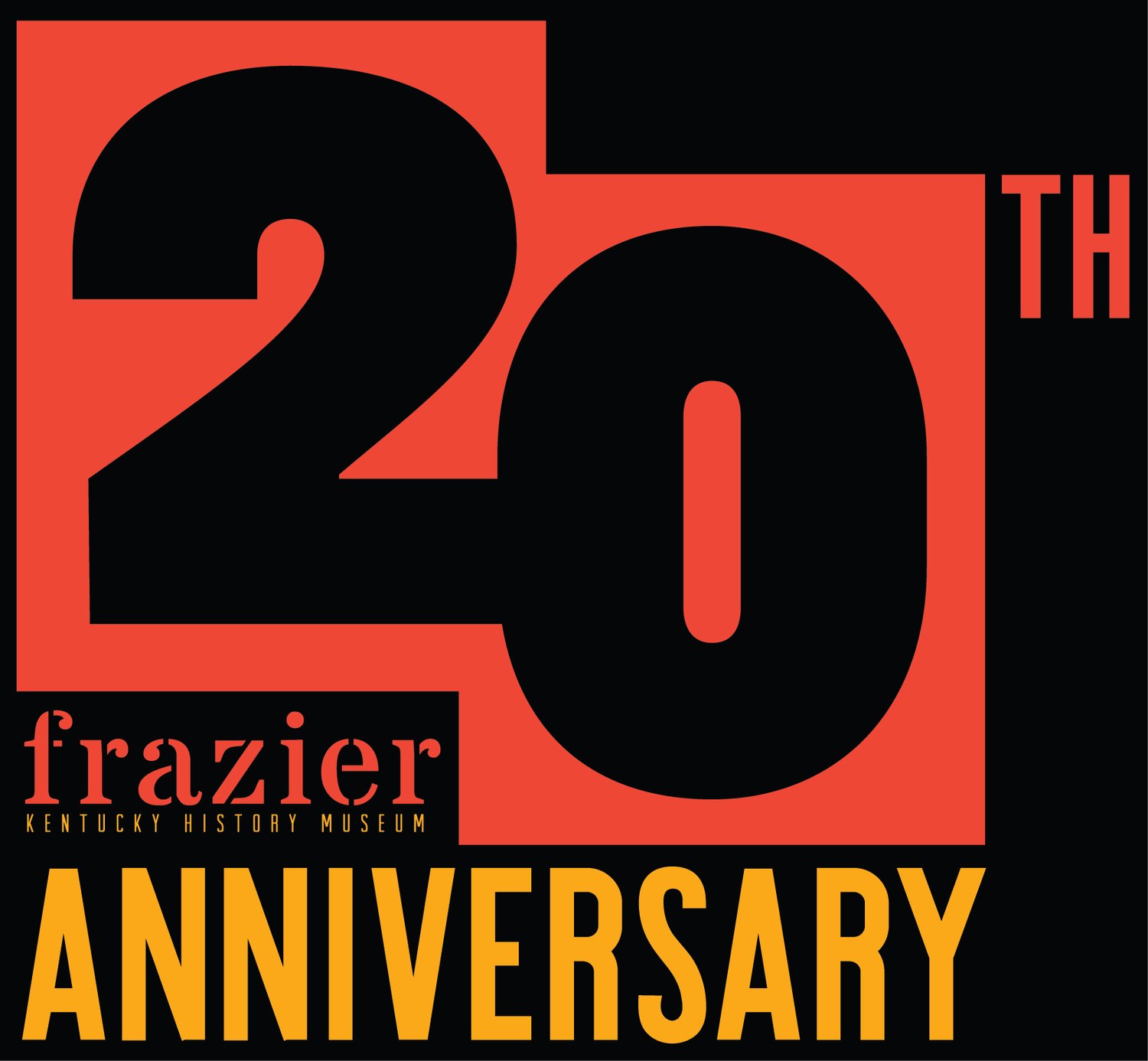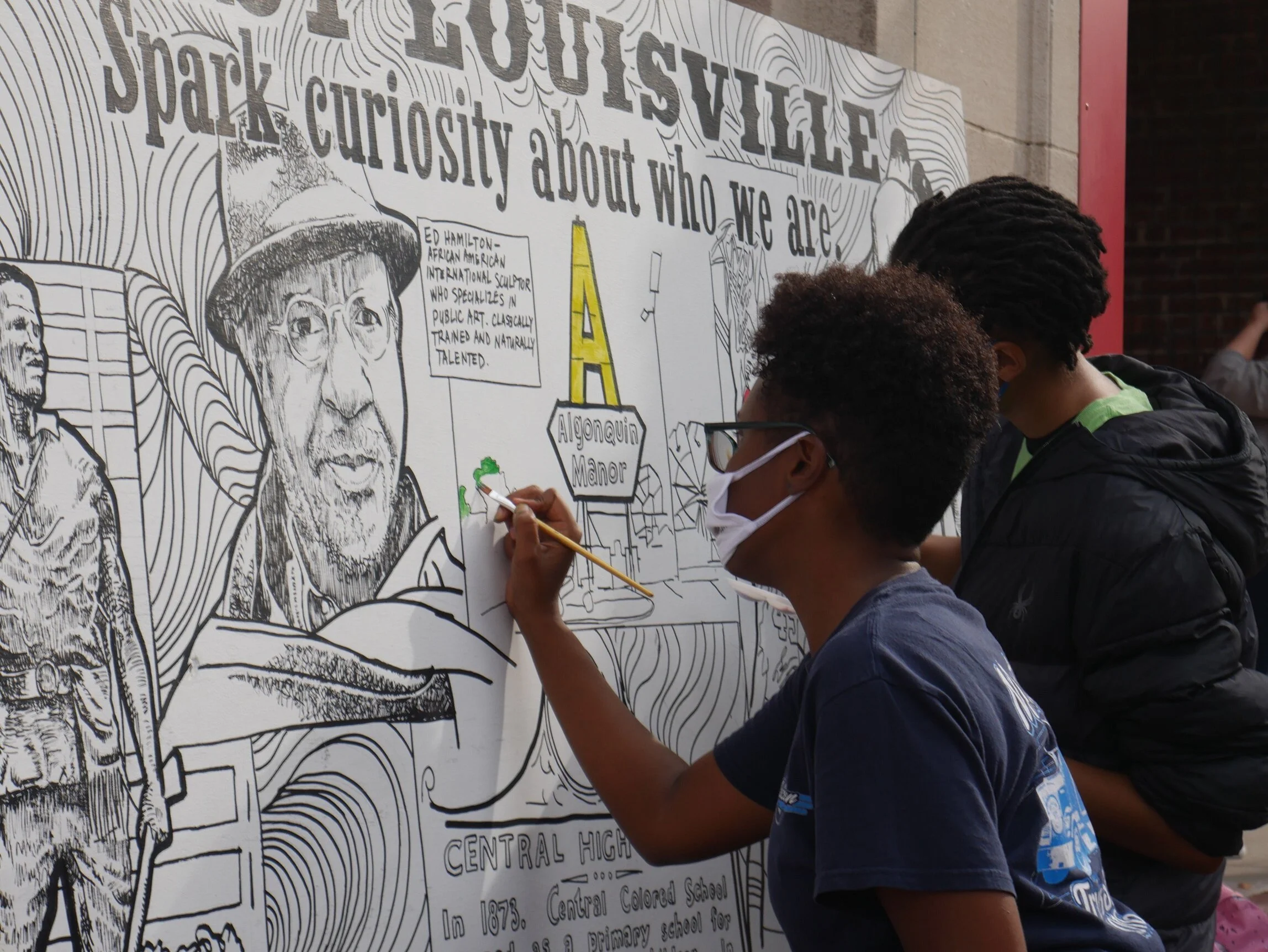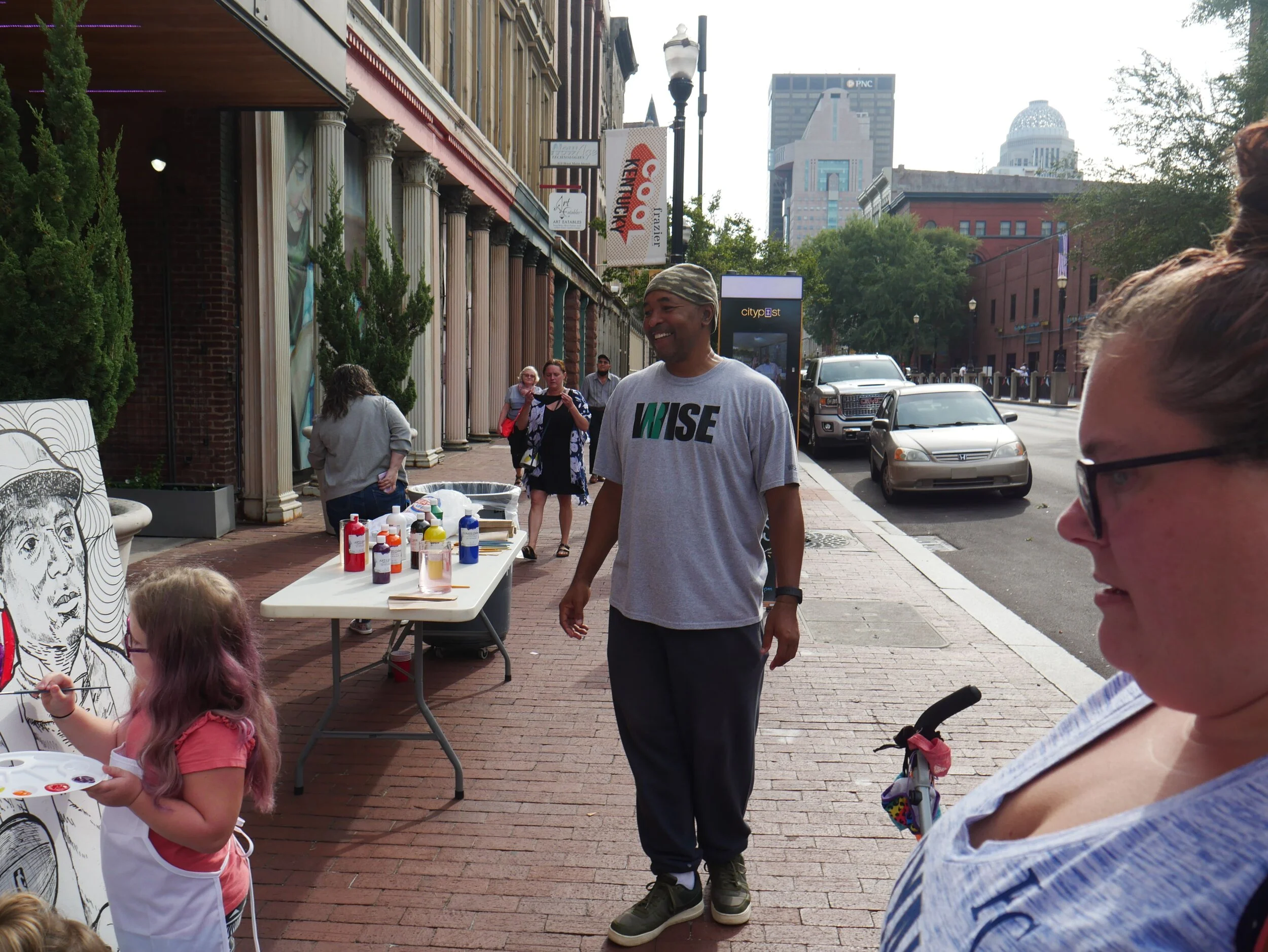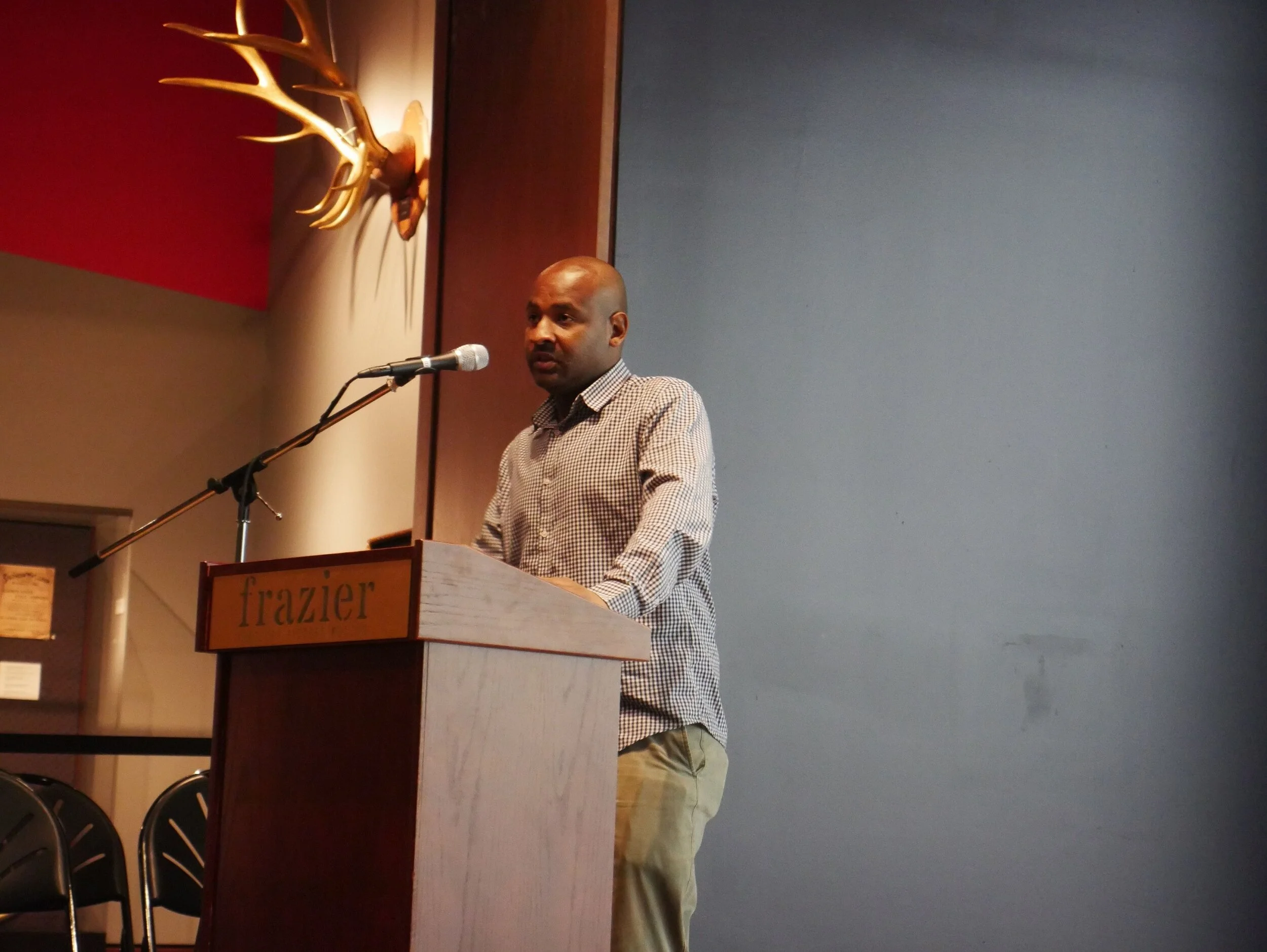Kickoff of West of Ninth, 1928 Atherton High School Dance Cards, Rebecca Ruth Candy’s Sesquicentennial Confection, and More
Walt and Shae Smith tell me a popular refrain they hear when they interview folks for their West of Ninth blog is, “I’ve been waiting for someone to ask me that.”
From left, Rachel Platt speaks with West of Ninth bloggers Shae and Walt Smith at the Frazier’s West of Ninth exhibition opening, September 18, 2021
Children participate in community art project with murals outside the Frazier’s front entrance on Main Street, September 18, 2021
I got the same response when I asked the founder of River City Drum Corps to be one of our Story Tellers for our upcoming “Racial Reckoning” conversation series: Ed White told me, “I’ve been waiting my whole life to tell this story.”
People telling their stories is a powerful thing, and for many, long overdue.
This weekend, the Frazier History Museum opened West of Ninth: Race, Reckoning, and Reconciliation, an exhibition based on the work of Walt and Shae Smith, who’ve interviewed hundreds of people in the nine neighborhoods west of Ninth Street about their lives. The exhibit shares those stories, and so did Walt and Shae during a special program on Saturday.
Following the killing of Breonna Taylor, the scope of our exhibition expanded to include issues that have impacted the Black community in Louisville that help explain the origins of the Ninth Street Divide.
Artist Victor Sweatt looks on during community art project featuring his murals, September 18, 2021
From left, Trey Latham and Maestro J perform in the Frazier’s Gateway Garden, September 18, 2021
So many folks turned out for our community opening on Saturday to delve into those hard histories, but also to learn about their and our neighbors, and to celebrate so many stories with renowned artist Victor Sweatt by painting murals that will live in the exhibition.
The painting happened on Main Street as Maestro J and Trey Latham played music above for inspiration.
Filmmaker Lavel White speaks, September 18, 2021
Corn Island Archaeology Principal Investigator Anne Bader shares artifacts recovered from the Beecher Terrace dig site, September 18, 2021
From left, JCPS teachers Rebecca Ingram, Katherine Rampley, Nick Howard, Mary Baunjoko, and Rebecca Custis, September 18, 2021
Lavel White shared his documentary, The Beecher Terrace Story, and Principal Investigator Anne Bader and others from Corn Island Archaeology shared the history of artifacts uncovered at the Beecher Terrace Housing Complex.
We also invited JCPS teacher leaders to talk, educators who are developing Inquiry Design Models (IDMs) focused on the history and artifacts of the Russell neighborhood community. Once completed, these educational resources will be publicly available to all local educators.
Our exhibition is now open for a year, and we hope you will come and experience it with an open heart and compassion for all members of the community. Many attendees I spoke with said they will come back and spend more time in the exhibit, to absorb it all and its importance.
Graphic for the September 30 program “Racial Reckoning: Housing”
The Frazier has also partnered with the Courier Journal and the Muhammad Ali Center for a four-part conversation series titled “Racial Reckoning” that will focus on Housing, Education, Policing, and Health, and many of those policies outlined in the exhibit.
The first program, held September 30 at the Frazier, is on Housing. You can click here to register.
Remember Ed White saying he’s been waiting his whole life to tell his story? He will tell it that evening, and I can’t wait to hear it. I hope you feel the same way and join me.
Stories are a powerful thing.
Rachel Platt
Director of Community Engagement
Frazier History Museum
This Week in the Museum
Museum Store: West of Ninth Neighborhoods T-shirt
West of Ninth neighborhoods t-shirt
Celebrated on this t-shirt are the nine neighborhoods that make up West Louisville, all of which are featured in our new exhibition West of Ninth: Race, Reckoning, and Reconciliation. Get a t-shirt for only $20 in the Museum Store and show your Louisville love.
Video: Ashland Native Pam Elam on Monumental Women
Monumental Women President Pam Elam speaks at a program
Women’s Rights Pioneers in Central Park in Manhattan in New York City. Sponsored by Monumental Women and made by sculptor Meredith Bergmann, the monument depicts women’s rights pioneers Sojourner Truth, Susan B. Anthony, and Elizabeth Cady Stanton. Unveiled August 26, 2020, in commemoration of the centennial of the ratification of the Nineteenth Amendment, it is the first monument to be added to Central Park since 1965 and the first in the Park to depict actual women. Credit: Monumental Women.
While new exhibitions such as West of Ninth are now open at the Frazier, we will always continue to share and support work that ties to What is a Vote Worth? Suffrage Then and Now, our exhibition on suffrage that ran from June 2020 to August 2021.
A case in point: the work of Ashland, Kentucky native Pam Elam, who is the President of the Board of Directors of Monumental Women, a non-profit whose goal is to move history forward.
Pam’s group did just that by, as they say, breaking the “bronze ceiling” in Central Park in New York: They commissioned the Women’s Rights Pioneers statue, the first statue in the Park to depict historical women.
Pam earned her undergraduate and law degrees from the University of Kentucky, beginning her lifelong fight for women’s rights before and after her education here.
Monumental Women just commemorated the one-year anniversary of the statue’s unveiling. Pam sent this special video to her friends in Kentucky for our recent Women’s Equality Day celebration at the Frazier.
We knew we had to share this video with you — it’s monumental.
Rachel Platt
Director of Community Engagement
Atherton High School Boat Ride and Junior-Senior Dance Cards, 1927 – 28
Copy of Freshman Guide of J. M. Atherton High School for Girls. Part of the Frazier History Museum Collection.
If you’ve tuned into our social media platforms lately, you’ll know the Frazier has started a new series called “What’s in Storage Wednesday?” that aims to highlight objects from our permanent collection. Most museums have the ability to display only five to 10 percent of their collection at a time and the Frazier History Museum is no exception. So, we hope this regular feature will allow us to share with you more of the stories held within our storage room’s walls as we make connections within our community.
We’re sharing our first permanent collection highlight, Freshman Guide of J. M. Atherton High School for Girls, because it’s part of a larger collection of high school ephemera from the late 1920s that provides a unique glimpse into the student experience of nearly a century ago. High school is something nearly all of us can relate to, perhaps even recalling what the start of our own freshman year was like. In fact, many aspects of this booklet look exactly like my own school’s did in 2010, with the school motto, policies, and information about the building and schedule. But I enjoy that the overall tone is more personal and less generic than my 21st century version. The administrator page, for example, is called “Introducing Some New Friends,” and includes poetic couplets such as “A friend in need is a friend indeed” underneath the section about the school’s principal.
The pamphlets that accompany Freshman Guidebook reflect the early days of Jefferson County Public Schools with which we’re familiar today. The three Junior-Senior Dance and Boat Ride cards do not indicate a specific school, but were likely associated with Atherton High School, as well. Atherton opened as an all-girls school in 1924, but became coeducational and moved to a new location by the 1960s. The original building on Morton Avenue now houses Jefferson County Traditional Middle School.
Card advertising the Junior-Senior Boat Ride, undated. Part of the Frazier History Museum Collection.
Card advertising the June 10, 1927 Junior-Senior Boat Ride. Part of the Frazier History Museum Collection.
Front cover of booklet advertising the Junior-Senior Dance, undated. Part of the Frazier History Museum Collection.
Invitation to the April 27, 1928 dance given by the Prospect Hop Club at Ballard School. Part of the Frazier History Museum Collection.
Vintage dance cards such as these, with a short pencil attached, often include a list of traditional dances with room to write the name of one’s dance partner beside each dance. The dance cards in our collection interestingly do not list any dances, but have several blank lines beneath the words “No Break.” The boat ride cards display a similar format, but with the words “Program” and “Extras.”
Page with “Program” and “Extras” sections in card advertising the Junior-Senior Boat-Ride, undated. Part of the Frazier History Museum Collection.
It appears the original owner of the cards wrote down the names of fellow classmates in all of the cards, indicating that they served as a way to keep track of the social activities of the evening. This was much more organized than my high school dance experience!
The fourth card shown is an invitation to a dance held in 1928 at the Ballard School (1914 – 1959), an event the original owner attended at a school other than her own, hosted by the Prospect Hop Club. The Rogers Clark Ballard Memorial School was created to replace four one-room schoolhouses in the area, but later closed as a result of changes in school district assignment. While the Arts & Crafts style building is now the privately operated Virginia Chance School, its name lives on in the nearby Ballard High School.
Together, this collection of cards and a booklet shows that although high schools practiced different social customs and presented student information differently in the 1920s, much of the student experience has remained the same. Students enjoy the anticipation of a Friday night dance, made even more exciting when only upperclassmen are allowed, and go through the same induction process to learn everything that unifies the student body. Even when classmates don’t know one another very well, they wear the same colors, chant the same cheers, and have to figure out where the library is.
Despite differences in formality or presentation throughout the decades, this collection serves as material evidence that high school, as a rite of passage, has maintained its integrity for a hundred years. And whether you are in high school, recently graduated, or far past those years, it opens up a door of collective memories and shared experiences.
Look out for more collection highlights on our social media platforms and our collections blog, coming soon to the Frazier Museum website!
Hayley Harlow Rankin
Manager of Collection Impact
Digging for a Promised Land: Town Clock Church in New Albany, Indiana
September 23, 2021
7 – 8:30 p.m.
Second Baptist Church (Town Clock Church)
300 East Main Street
New Albany, IN 47150
Join us for an evening of discovery connecting archaeological investigations within two different North American urban settings that connect our community with fascinating local people and stories from the past two centuries. Participants will hear from Anne Bader, Principal Archaeologist with Corn Island Archaeology, and Karolyn Smardz Frost, an archaeologist living in Canada and the author of I’ve Got a Home in Glory Land, which shares the stories of freedom seekers Thornton and Lucie Blackburn.
Special thanks to the Caesars Foundation of Floyd County for their generous support of this program. Seating is limited and advance registration is required.
To learn more or to make reservations, click here.
Megan Schanie
Manager of School and Teacher Programs
Cool Kentucky Teacher Series 2021 – 22
Graphic for Cool Kentucky Teacher Series 2021 – 22
In celebration of our latest permanent exhibition, Cool Kentucky, the Frazier History Museum is pleased to offer a series for local educators highlighting three of the many themes represented in the exhibit: Kentucky music, Kentucky’s natural world, and trailblazing Kentucky women. Each session will highlight artifacts and stories from the Frazier exhibition and connect teachers with a local expert sharing their knowledge and educational resources.
Cool Kentucky Teacher Series: Kentucky Music
October 9, 2021, 10 a.m. – 12 p.m.
Kentucky music shines as the centerpiece of the first program in the three-part series. Educators will discover the stories of trailblazing Kentucky musicians, including Sara Martin, Sylvester Weaver, Lily May Ledford, and more. Experience a screening of The Way Forth — a folk opera and film created by local pianist, composer, and arranger Rachel Grimes that honors the legacy of the silenced by giving voice to women throughout Kentucky history. And enjoy a presentation from Kiana Del, Engagement Manager for Music Education with Louisville Public Media, to learn about 90.5 WUOL’s “Local Legends” video series and how to best utilize it in the classroom.
Save the Dates
January 15, 2022 — Cool Kentucky Teacher Series: Natural Kentucky
April 16, 2022 — Cool Kentucky Teacher Series: Trailblazing Kentucky Women
Thanks to a generous anonymous donor, educators are invited to enjoy the sessions at no charge. Space is limited and advance registration is required. To learn more or make reservations, click here.
Megan Schanie
Manager of School and Teacher Programs
History All Around Us
Rebecca Ruth Candy and the 1936 Origin of the Bourbon Ball
From left, Ruth Hanly Booe and Rebecca Gooch riding horses, undated. Credit: Rebecca Ruth Candy.
In 1964, the U.S. Congress designated Bourbon whiskey — a distilled spirit produced in this country for over 200 years — a unique product of the United States. In 2007, the U.S. Senate recognized Bourbon as America’s native spirit when it declared September to be National Bourbon Heritage Month. Today, 90 to 95% of all Bourbon is made in Kentucky.
Needless to say, there’s no better time or place to try delightful, tasty, Bourbon-based recipes than Kentucky in September.
One of the most iconic Bourbon recipes produced in Kentucky is Bourbon balls, a product developed by a woman named Ruth Hanly Booe. Ruth and Rebecca Gooch were substitute schoolteachers in Frankfort, Kentucky who made candies for family and friends as gifts. The candies were so well-received, the women decided to pursue the project full-time — a transition Vinepair contributor Emily Bell characterizes brilliantly:
“And at some point in 1919, it must have occurred to them that they were better at molding chocolate than molding young minds, because they left chalkboards and abacuses and other old-timey educational tools behind to found Rebecca Ruth Candy — today, known as Rebecca Ruth Chocolates.”
Ruth Hanly Booe hand-stretching Kentucky Creamed Pull Candy at Jet, 1923 – 33. Credit: Rebecca Ruth Candy.
To improve sales in their new company, Ruth and Rebecca were enterprising and resourceful, even approaching individuals directly on the street to offer samples.
In 1924, Ruth married Charles Douglas Booe and moved to northern Kentucky where her husband worked on the design of a bridge as an engineer. Ruth continued to make candy in the basement of their apartment and sold it wholesale to stores and hotels as far away as the Golden Lamb Hotel in Lebanon, Ohio. A few years later, Ruth gave birth to a son; but her husband passed away, at which point she decided to return to Frankfort and rejoin Rebecca.
Shortly thereafter, Rebecca married and in 1929 sold her share of the business to Ruth — just as the Great Depression hit. The Depression was followed by other difficulties, including a devastating fire that destroyed her home and business and the refusal by every bank in Frankfort to loan her needed capital to rebuild.
However, in 1936, Ruth was asked to bring chocolates to the Frankfort sesquicentennial celebration at the Governor’s Mansion. It was there that Eleanor Hume Offutt O’Rear, a dignitary at the event, mentioned to Ruth that the two best tastes in the world are a bite of chocolate followed by a sip of Kentucky Bourbon.
From left, (front row) Elizabeth Robbins, Ruby Robbins, and Edna Robbins; (back row) Rebecca Gooch, and Ruth Hanly Booe, c. 1944. Credit: Rebecca Ruth Candy.
Offutt’s comment inspired Ruth, who spent the following two years perfecting a recipe for blending Bourbon and chocolate — a recipe that remains secret to this day. Her resulting Bourbon ball candy was a success. Today, Rebecca Ruth Candy makes an estimated 5 million pieces of candy a year, of which 3 million are Bourbon balls made with Evan Williams Bourbon.
Ruth retired in 1964. Her grandson now owns and operates the company, which is still located in Frankfort. Ruth, who remained close friends with Rebecca Gooch to the end of her life, died in 1973.
Rebecca Ruth Chocolates can be ordered online via their website.
A box of Rebecca Ruth Candy’s Bourbon Balls. Credit: Rebecca Ruth Candy.
However, in my family, we like to make our own Bourbon balls each holiday.
Today, you will find numerous versions of the recipe. Some recipes will mix crushed vanilla wafers with the confectioners’ sugar or mix Bourbon-soaked chopped pecans into the fondant and omit the single whole pecan on the top of each candy. Others make the candy like a truffle and roll it in cocoa or confectioners’ sugar. However, my family is purist. We use the Bourbon in the creamed center, dip the chilled fondant in dark chocolate, and place a whole pecan on top of each piece of candy.
Yates Family Bourbon Balls
Ingredients
1 pound box confectioners’ sugar
½ cup unsalted butter, softened
1 teaspoon vanilla
Generous pinch of salt
½ cup Bourbon
4 oz. semisweet chocolate and 4 oz. unsweetened baking chocolate
4 tbsp. grated paraffin (this can be omitted, but it adds a nice shiny finish to the candy when it hardens)
Pecan halves for topping
Directions
In a large bowl, cream the butter using an electric mixer. Add confectioners’ sugar, salt, vanilla, and Bourbon and mix until blended. Refrigerate for about an hour or until firm but workable.
Pinch off about a rounded teaspoonful of cold mixture and roll it into a 1-inch ball. Place the ball on a waxed paper-lined pan and continue making the balls until the mixture is used. Place the pan in the refrigerator or freezer, until balls are very cold, but not frozen, about 2 hours.
Melt chocolate and paraffin in a small double boiler and stir until smooth. When the chocolate is melted and the Bourbon balls are cold and firm, use a long toothpick to dip each ball into the melted chocolate. Swirl it around to completely cover the ball, then remove it quickly and place it back on the waxed paper-lined pan.
Immediately place a pecan half on top of the chocolate-dipped Bourbon ball and press to set. Continue dipping until all Bourbon balls are completed. Store in refrigerator up to 2 weeks or freeze for longer term storage. Serve at room temperature.
Vickie Yates Brown Glisson
Board Member, Frazier History Museum
Guest Contributor
Calendar of Events
In Case You Missed It: “Cool Kentucky: Hometown Magic” (Sep. 12)
From left, Ken Abbott, Andy Treinen, Lance Burton, Mac King, Michael Raymer, and Rachel Platt at the “Cool Kentucky: Hometown Magic” program in the Frazier Museum’s Fourth Floor Loft, September 12, 2021
From left, Lance Burton and Mac King look at the props they loaned to the Frazier, which are on display in the “Magic Kentucky” section of the Cool Kentucky exhibition on the first floor of the museum, September 12, 2021
Whenever you get magicians Lance Burton and Mac King in the same room, well, it’s magic.
For those who attended our program on Sunday, September 12, you got your money’s worth, and then some — even special tributes to both magicians.
Our panel discussion revealed great inside stories about their lives, their appearances on national TV shows, how they’ve been best friends and supporters of one another since the age of 14, and how it all started in Louisville with their love of magic.
Then the magic show took place, and what a show! Afterwards, both performers stayed until they greeted, took pictures with, and signed autographs for everyone who wanted to meet them. Lance and Mac even obliged the last fan, who asked for something rather unique!
Lance and Mac autographing an attendee’s head, September 12, 2021. Credit: Louisville Magic Club.
We then took Lance and Mac to the first floor, where they got to see their personal items on display in our Cool Kentucky exhibition.
If you couldn’t make it to the show, abracadabra, here it is!
Rachel Platt
Director of Community Engagement





























